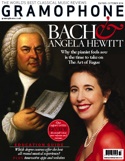Texte paru dans: / Appeared in:
*

GRAMOPHONE (10/2014)
Pour s'abonner /
Subscription information
Sony 88843036822

Code-barres / Barcode : 0888430368224
(Classicalacarte ID471)
Consultez toutes les évaluations recensées pour ce cd
~~~~ Reach all the evaluations located for this CD
 (10/2014) (Recording of the month)
(10/2014) (Recording of the month)
Reviewer:
Stephen Plaistow
‘When in trouble, play Bach’ – wise advice from Edwin Fischer to a pupil. He was making an observation to a fellow performer about Bach’s restorative and reorienting powers; no doubt, but perhaps alerting all of us to the inspiring breath we can draw from the fertility and humanity of a composer whose imagination and ‘habit of perfection’ (John Eliot Gardiner’s phrase) drove him to discover in music just about everything. For the keyboard player, an engagement with Bach is a constant from childhood, and it becomes essential to daily life. For Beethoven, for Mozart in his maturity and for Chopin, it was the same. ‘Practise some Bach for me,’ Chopin used to say to his departing pupils as they went through the door. Yet no music is more demanding to realise in sound, nor quicker to reveal inadequacies of perception. Which brings me to Igor Levit – and not a moment too soon, you may think. The distinction of this set of the Partitas, following his Sony debut recording of the last five Beethoven sonatas (11/13), will establish him in the minds of many, I’m sure, as a major artist. He played those sonatas as though he had lived with late Beethoven a long time and had perceived and understood everything. His versions of the six Bach Partitas show a comparable address and maturity. Above all, they are fresh and joyous.
‘The distinction of this set of the Bach Partitas will establish Igor Levit in the minds of many, I’m sure, as a major artist’
How demanding they are. On the title-page of the collected edition of 1731, brought out as his Op 1 and a selfpublishing job, Bach said he had composed them ‘for music lovers, to delight their senses’. They soon made a great noise in the musical world but earned him, too, a reputation for their technical difficulty: as if, as a contemporary put it, the composer had expected ‘what he alone could do on the keyboard’. An early player of them, said to have been accomplished, described them as ‘making me seem like a beginner each time’.
Complex music – but not complicated. Levit’s achievement is to miss nothing of their scope and variety as compositions while conveying what it is that makes each one a unity, not an anthology, demanding to be performed complete. Where other practitioners offer regular accents and a perhaps over-cautious traversal, tethered to the notes, Levit never fails to project a commanding overview – an aerial perspective, almost – in addition to the detail of phrasing and articulations and the nooks and crannies of melodic lines. Only the most gifted interpreters manage both. It energises his performances and makes them seem to inhabit a state of grace. And it contributes to our enjoyment in another way, drawing us on as we listen and keeping us curious as to what lies around the next corner. A first impression might be of quicker tempi than usual and of a fleetness that challenges us to keep up. Yet one quickly registers that nothing, in fact, is rushed or driven too hard – not a phrase or a paragraph, nor even (most important) the execution of an ornament.
I like very much Levit’s ornaments and embellishments in general. They are always a living feature of the line, arising from within, not stuck on from without. In addition they show awareness of performance practice and what may be appropriate in each instance, with decoration added to ‘second times’ discreetly and with an air of spontaneity, and never to excess. Levit has a sure judgment of when to leave well alone, as CPE Bach advised when discussing this aspect of his father’s music. The majestic Sarabande of No 1 in B flat (disc 1, tr 4) gets a minimum of graces in its repeats – barely noticeable indeed. But there needs to be some if ‘second time through’ is to have any sense; otherwise why do it?
The playing of the Gigues in the Partitas – and the final Capriccio in No 2 in C minor – invite the performer’s virtuosity as a welcome guest to the feast. Levit doesn’t disappoint. Bach developed these movements to make thrilling conclusions, just as he had made the opening of each work something imposing and unexpected.
That was possibly his most original contribution to the suite of his time: there’s a Praeludium in No 1, a three-part Sinfonia in No 2, a French Overture in No 4 (the D major), a Praeambulum in No 5 and a grand Toccata and Fugue in No 6 (E minor). They help to make each partita announce itself as something ambitious and a unity, not just a succession of dances. With Levit, if you start at the beginning, to be some if ‘second time through’ is to have any sense; otherwise why do it?
The playing of the Gigues in the Partitas – and the final Capriccio in No 2 in C minor – invite the performer’s virtuosity as a welcome guest to the feast. Levit doesn’t disappoint. Bach developed these movements to make thrilling conclusions, just as he had made the opening of each work something imposing and unexpected.
That was possibly his most original contribution to the suite of his time: there’s a Praeludium in No 1, a three-part Sinfonia in No 2, a French Overture in No 4 (the D major), a Praeambulum in No 5 and a grand Toccata and Fugue in No 6 (E minor). They help to make each partita announce itself as something ambitious and a unity, not just a succession of dances. With Levit, if you start at the beginning, to be some if ‘second time through’ is to have any sense; otherwise why do it?
The playing of the Gigues in the Partitas – and the final Capriccio in No 2 in C minor – invite the performer’s virtuosity as a welcome guest to the feast. Levit doesn’t disappoint. Bach developed these movements to make thrilling conclusions, just as he had made the opening of each work something imposing and unexpected.
That was possibly his most original contribution to the suite of his time: there’s a Praeludium in No 1, a three-part Sinfonia in No 2, a French Overture in No 4 (the D major), a Praeambulum in No 5 and a grand Toccata and Fugue in No 6 (E minor). They help to make each partita announce itself as something ambitious and a unity, not just a succession of dances. With Levit, if you start at the beginning, to be some if ‘second time through’ is to have any sense; otherwise why do it?
The playing of the Gigues in the Partitas – and the final Capriccio in No 2 in C minor – invite the performer’s virtuosity as a welcome guest to the feast. Levit doesn’t disappoint. Bach developed these movements to make thrilling conclusions, just as he had made the opening of each work something imposing and unexpected.
That was possibly his most original contribution to the suite of his time: there’s a Praeludium in No 1, a three-part Sinfonia in No 2, a French Overture in No 4 (the D major), a Praeambulum in No 5 and a grand Toccata and Fugue in No 6 (E minor). They help to make each partita announce itself as something ambitious and a unity, not just a succession of dances. With Levit, if you start at the beginning, to be some if ‘second time through’ is to have any sense; otherwise why do it?
The playing of the Gigues in the Partitas – and the final Capriccio in No 2 in C minor – invite the performer’s virtuosity as a welcome guest to the feast. Levit doesn’t disappoint. Bach developed these movements to make thrilling conclusions, just as he had made the opening of each work something imposing and unexpected.
That was possibly his most original contribution to the suite of his time: there’s a Praeludium in No 1, a three-part Sinfonia in No 2, a French Overture in No 4 (the D major), a Praeambulum in No 5 and a grand Toccata and Fugue in No 6 (E minor). They help to make each partita announce itself as something ambitious and a unity, not just a succession of dances. With Levit, if you start at the beginning, to be some if ‘second time through’ is to have any sense; otherwise why do it?
The playing of the Gigues in the Partitas – and the final Capriccio in No 2 in C minor – invite the performer’s virtuosity as a welcome guest to the feast. Levit doesn’t disappoint. Bach developed these movements to make thrilling conclusions, just as he had made the opening of each work something imposing and unexpected.
That was possibly his most original contribution to the suite of his time: there’s a Praeludium in No 1, a three-part Sinfonia in No 2, a French Overture in No 4 (the D major), a Praeambulum in No 5 and a grand Toccata and Fugue in No 6 (E minor). They help to make each partita announce itself as something ambitious and a unity, not just a succession of dances. With Levit, if you start at the beginning, you go on to the end; no question. Bach mediates between the French and the Italian styles in the course of the six works, and Levit doesn’t miss a trick. Finally, let me praise his cantabile playing (a singing style), which Bach extolled to his students as a constant aim.
Harpsichord or piano? Forget it. Or rather, let us have both. If on the piano, however, which isn’t a second-best, I incline to those exponents who are not apologetic about their instrument and at the same time show awareness, relish even, of what the best harpsichordists have achieved, from Gustav Leonhardt to Andreas Staier (I mention two exceptional players who have made complete sets). As to other pianists, I would cite Richard Goode, on a par with Murray Perahia; maybe András Schiff as well. Levit’s version has added to the discography of this inexhaustible music with distinction and I believe it will run and run. There’s nothing about him in the booklet – as if to say, it’s not about me, the music is enough. But if you haven’t come across him before I can report that he’s of Russian-German descent (shades of Sviatoslav Richter) and is 27 this year. I wonder what he’ll do next.
Cliquez l'un ou l'autre
bouton pour découvrir bien d'autres critiques de CD
Click either button for many other reviews


